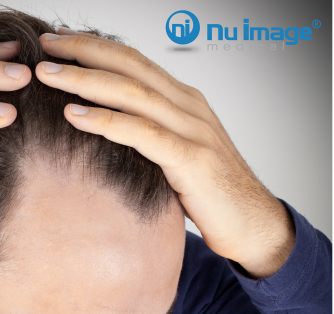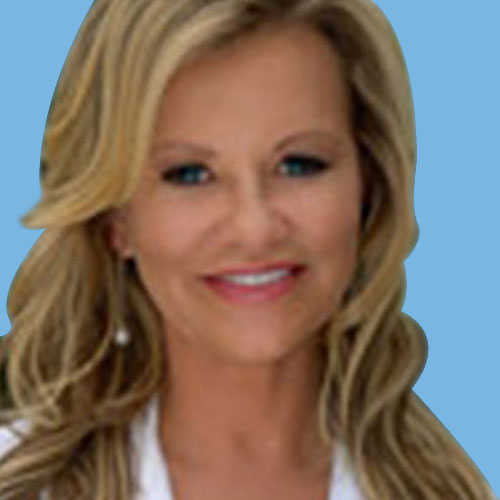Menu
Weight loss
Hormones
Sex
EXPLORE
MEET NU IMAGE MEDICAL
TREATMENTS
MEET NU IMAGE MEDICAL
TREATMENTS
MEET NU IMAGE MEDICAL
A Quick Breakdown of Balding


The human body is covered in hair, although a lot of the hair is so fine you can’t see it. The soles of your feet and the palms of your hands don’t grow hair, while other areas of the body, such as the scalp, produce hair with a different texture from the nearly invisible strands that cover the rest of the body. Hair production is the work of hair follicles and a protein called keratin. The visible hair strands you see are actually long lines of dead keratin cells, since follicles produce new hair cells and push the old ones out through the skin as a part of the growth process.
The Hair Growth Process
Each year, follicle production results in about six inches of hair growth, and usually, about 90% of the hairs on a scalp are growing at one time. Through it seems that your hair grows at the same rate, each follicle has a life cycle of its own. These cycles are influenced by age and disease, as well as other factors. There are three primary phases of hair growth. In the first anagen phase, the follicles are actively engaged in growth. This period can last anywhere from two to six years. The follicles then move into a catagen phase, in which a transition growth phase lasts from about two to three weeks. The last phase is the telogen phase, which is the resting phase for the hair follicle. This part can last about two to three months, and when it comes to an end, the hair strand is shed from the scalp. The growing cycles start at this point and replace the lost strands with new hair.
Dealing With Alopecia
The rate of hair growth tends to slow down as people age. In some cases, this leads to noticeable cases of alopecia. This is the term used for balding, although some prefer to use this term interchangeably with all types of hair loss. Since there are many reasons for thinning, shedding, or total loss, there are several types of alopecia.
1. Androgenic alopecia. In this genetic condition, both males and females can experience baldness. Male pattern baldness is the term associated with male loss issues, and the condition can begin as early as the teens or 20s for some men. The first signs are a receding hairline, where there is a gradual disappearance of hair from around the front of the scalp and around the crown. Most see the loss in the shape of a letter “M” around the scalp. The hair around the back of the scalp isn’t usually a part of loss with this condition. Females can experience female pattern baldness, although this condition doesn’t usually occur until the mid to late 40s. It begins with noticeable thinning throughout the scalp, but there is more significant loss around the crown.
2. Involutional alopecia. This natural condition occurs when individual ages. There is an increase in the number of hair follicles enter the resting phase, while the other follicles experience a slower growth rate. This causes the hairs that haven’t fallen out to be shorter.
3. Alopecia universalis. With this loss, all of the body experiences loss. The body hair, including eyelashes, eyebrows, and pubic hair, completely falls out.
4. Alopecia areata. Children and young adults can experience hair problems, and although many times loss is associated with hair care routines or harsh hairstyles, this is a medical condition. Loss starts suddenly in patches around the scalp, and sometimes, total baldness can occur. This becomes known as alopecia totalis. For about 90% of those who suffer from this condition, their hair return in a few years.
5. Telogen effluvium. Some hair challenges are temporary, such as with this condition where temporary thinning occurs during the changing cycles of hair growth. It is more noticeable when a large quantity of hair follicles enters the telogen or resting phase at the same time. This increases the number of hairs shed at the same time.
6. Trichotillomania. In this distressing situation, children suffering from a psychological disorder will pull out their own hair. This condition can be reversed once the child or individual receives proper medical attention.
7. Scarring alopecia. This form of balding a permanent loss of hair. When there are inflammatory skin conditions or disorders plaguing the scalp, it can cause scarring and damage to the hair follicles. Follicles are unable to generate new hair.
Treatment for Balding
Fortunately, for those who suffer from balding or hair loss, there are treatment options available. Medications containing minoxidil or finasteride helps reduce the rate of loss and encourage hair follicles to re-enter the active growth phase. Starting these protocols at the first sign of a problem improves the chances of a successful treatment plan.
This article is for informational purposes only and does not constitute medical advice. The information contained herein is not a substitute for and should never be relied upon for professional medical advice. Always talk to your physician about the risks and benefits of any treatment. Nu Image Medical may not offer the medications or services mentioned in this article.
